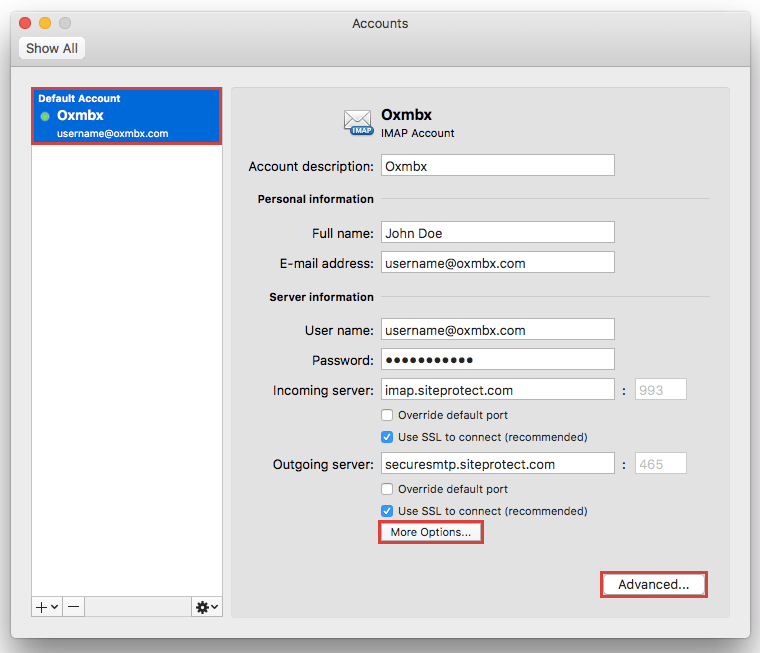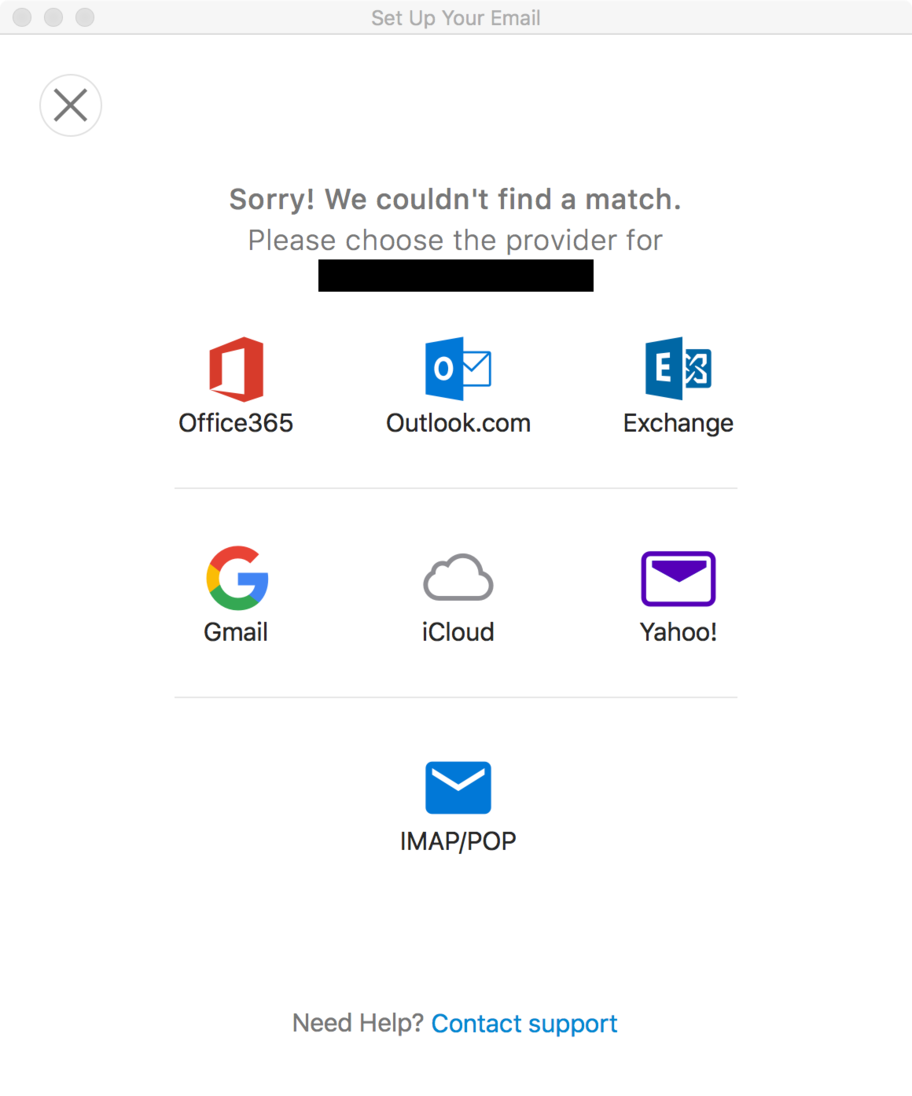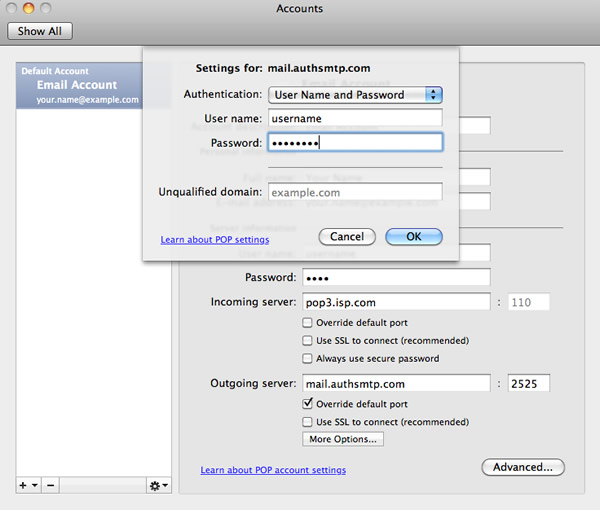Follow these steps to manually configure Outlook for Mac 2011, Outlook 2016 for Mac, and Outlook 2019 for Mac. In the Tools menu, choose Accounts. In the Accounts dialog box, choose + and New Account, type your Email Address, choose Continue, and under Choose the provider, choose Exchange. POP e-mail accounts If you want to sync your POP e-mail, you first need to add the account to Outlook. For more information about how to add an account, see Add an email account to Outlook for Mac. After that, you can use schedules to set when you want Outlook to synchronize with the POP mail server by sending or receiving mail messages. Refer to your email app's documentation for information about how to use these settings. ICloud Mail uses the IMAP and SMTP standards supported by most modern email apps. ICloud does not support POP. If you set up an account using iCloud System Preferences or macOS Mail in 10.7.4 or later, you won't see these settings because they're. Click the user's Display Name to view the settings for the user’s mailbox. Click Advanced Settings. Make sure that POP3 (IMAP4) checkbox is selected. If POP3 (IMAP4) options are not enabled, select them and click Save Changes button. Outlook for Mac setup. The same process applies to both Outlook for Mac 2011 and 2016 versions. Enter your name and e-mail address. Select POP3 for the account type and enter pop.mail.com as incoming server and smtp.mail.com as outgoing server. Enter your mail.com username and password. Uncheck Test Account Settings by clicking the Next button. Click on More Settings.
- See Full List On Support.microsoft.com
- Basic Pop Account Settings For Outlook For Macs
- Basic Pop Account Settings For Outlook For Mac Osx
- How To Set Up ActiveSync Email Account In 2016
Once you’ve configured and activated your HostPapa email service, you can proceed to set up your email account in Outlook 2016.
For easy webmail access, you can always use https://webmail.yourdomain.tld URL (replace yourdomain.tld with your actual domain) or https://mail.papamail.net/ if you utilize Basic/Advanced email service from any browser.
Automatic account setup
The first time you run Outlook 2016, you’ll see a welcome screen that looks like this:
Click Next to get started.
If you’ve previously configured Outlook 2016, click the File tab at the top of the window and in the Info category, click the Add Account button.
In the Add an Email Account wizard displayed, you’ll be asked Do you want to set up Outlook to connect to an email account? Ensure the radio button next to Yes is selected, then click Next.
In Auto Account Setup panel, enter the following details:
- Your Name: Enter the name you’d like to appear on your emails.
- Email Address: Your full email address.
- Password: Your email account password.
- Retype Password: Enter your email account password again.
Click Next. Outlook will now attempt to retrieve your email server details and set up account access.
Manual setup
If your server cannot be found, check that the email address you entered is correct and try again. You can enter your server details manually by selecting Manual setup or additional server types. Then, click Next.
Outlook 2016 supports standard POP3/IMAP email accounts, Microsoft Exchange or Office 365 accounts, as well as webmail accounts from a range of providers including Outlook.com, Hotmail, iCloud, Gmail, Yahoo and more. For HostPapa email services, select POP or IMAP.
Manually set up POP3 or IMAP email accounts
Once you have clicked the radio button next to POP or IMAP, select Next to proceed with your email account configuration. You’ll need your email server details, username and password to hand.
Enter the following details:
- Your Name: Enter the sender’s name you’d like to appear on your emails.
- Email Address: Your full email address.
- Account Type: Use the dropdown menu to select POP3 or IMAP.
- Incoming mail server: For POP or IMAP accounts use mail.yourdomain.tld if you’re on shared plan (replace yourdomain.tld with your actual domain) or mail.papamail.net if you use Basic/Advanced Email services.
- Outgoing mail server (SMTP): For POP or IMAP accounts use mail.yourdomain.tld if you’re on shared plan (replace yourdomain.tld with your actual domain) or mail.papamail.net if you use Basic/Advanced Email services.
- User Name: Your email account username.
- Password: Your email account password.
Now click the More Settings… button. In the Internet Email Settings window that opens, select the Advanced tab.

Enter the following details:
- Incoming server: Ensure the default port is set to 995 for POP accounts, or 993 for IMAP accounts. Click the checkbox next to This server requires an encrypted connection (SSL).
- Outgoing server (SMTP): Change the default port (25) to 465 for POP or IMAP accounts. Use the dropdown menu next to Use the following type of encrypted connection to select SSL.
Switch to the Outgoing Server tab. Check the box next to My outgoing server (SMTP) requires authentication, then click the radio button next to Use same settings as my incoming mail server.
Click OK to close the Internet E-mail Settings window. In the POP and IMAP Account Settings window, click the Test Account Settings… Adobe pdf reader for mac el capitan dmg. button to ensure Outlook can communicate with your email server.
If the test fails, retrace your steps, ensuring your server and account details have been entered correctly.

Once the test completes successfully, click Next and then Finish to wrap up.
If you notice any problems or if you need any help, please open a new support ticket from your HostPapa Dashboard.
This article is also available in:FrenchSpanishGerman
Using a Mac OSX PC and running another account along with its default email client will be added advantage. Due to user convenience, people can follow these steps and can set up your Exchange Email Account in Mac OS.
Before setting up any account, make a note that users have to create an email account using Mail. The steps are given below as:
Steps to follow before creating any account:
- Open Mail and then select Preferences.
When you will click Preferences, a tab will be opened named Account. Click it.
A window will be opened for Account and now click + at the bottom of the window.
Now enter your credentials (user name, password and e-mail id) and then click Continue.
Now click Create.
The email account will be set automatically.
Steps to create Office 365 Email Account on Mac OS X:
Using Office 365 has bought a revolution as the applications are accessed through 128-bit SSL/TSL encryption. This ensures a security feature in accordance with the Microsoft Trustworthy Computing initiative.
After security, the major concern is reliability. Using Office 365, if there is an outage at one datacenter, the other can act as a backup.
Another scene about using Office 365 is that the user mailboxes are supported up to 25 GB (they can be customized too). Seeing these advantages, let us initiate to create Office365 Email Account on Mac OS X:
Step 1: Start Mac Mail.
Step 2: Click Mail > Add Account.
Step 3: Now enter Full Name, Email Address and Password, and then click Continue.
Step 4: An Incoming Mail Server window will be opened. Set the Account Type as Exchange and set the description to identify your account (e.g Office 365).
Step 5: Set the Incoming Mail Server to “outlook.office365.com”. Set the User Name and enter Password.
Tick the Contacts and Calendars in the “Also Setup” field.
Step 6: Click Continue.
Step 7: Your account summary will be displayed and click Create.
Step 8: OS X Mail will be connected to your new Office 365 account.
Steps to create POP Email account On Mac OS X:
This is a short from for Post Office Protocol version 3. Using POP3, the e-mail is sent to your address is stored on the mail server until it is downloaded via your e-mail client. After the download of the e-mail, it is removed from the server altogether.
Having a POP3 account, the user can read emails as it creates a local copy in computer and the original message is deleted from the server.
See Full List On Support.microsoft.com
Step 1: Start Mac Mail.
Step 2: Click Mail > Add Account.
Step 3: Now enter Full Name, Email Address and Password, and then click Continue.
Step 4: An Incoming Mail Server window will be opened. Set the Account Type as POP and set the description to identify your account.
Step 5: Set the Incoming Mail Server to pop3.hosts.co.uk. Set the User Name as your mail box name and enter Password, then click Continue.
Step 6: Check mark the box Use Secure Sockets Layer.
Step 7: Set Authentication to Password and click Continue.
Step 8: After clicking Continue, enter the Description for your Outgoing Mail Server. If you have purchased Authenticated SMTP Access, set the server name and check mark Use Only This Server.
Step 9: Now Tick Use Authentication and enter the User Name and Password, then click Continue.
Step 10: Your account summary will be displayed. Check mark Take Account Online and click Create.
Steps to create IMAP Email account On Mac OS X: Mahjong app for mac. Free gis maps online.
It is known as Internet Message Access Protocol. From the above stated POP3 account, IMAP is the better option as the user can tap into the synced (updated) account from any device with IMAP. In case of POP3, email is downloaded from a server to a single computer, and then it is deleted from the server.
Step 1: Start Mac Mail.
Step 2: Click Mail > Add Account.
Step 3: Enter Full Name, Email Address and Password, and click Continue.
Step 4: In the Incoming Mail Server window, set the Account Type as IMAP and set the description to identify your account.
Step 5: Set the Incoming Mail Server to imap.1and1.com. Set the User Name and enter Password, then click Continue.
Step 6: After clicking Continue, a notice will be shown as Additional Account Information Required, click Next.
Step 7: Now enter the additional Incoming Mail Server Info (Enter Port No, Check mark Use SSL and enter Password), then click Next after finished.
Step 8: Your account summary will be displayed. Check mark Take Account Online and click Create.
Step 9: OS X Mail will be connected to your new IMAP account and downloading will begin to your inbox.
Steps to create Exchange Email account On Mac OS X:
This protocol is introduced by Microsoft and all email items are stored on the central Exchange mail server that can be checked using a capable mail client (such as MS Outlook). Messages can also be saved in local folders locally offline.
Step 1: Start Mac Mail.
Step 2: Click Mail > Add Account.
Step 3: Select Exchange and click Continue.
Step 4: Type your name, email address and password, click Continue.
Step 5: In the Incoming Mail Server window, set the Account Type as Exchange 2007. (EI Capitan users may not see this window) and set the description to identify your account.
Step 6: Set the Incoming Mail Server to mail.ucsd.edu. Set the User Name and enter Password.
Step 7: Check mark Address Book Contacts and iCal calendars, then click Continue.
Step 8: Mac OS 10.8.x users may see additional screen for ‘Incoming Mail Security’. Check mark Use SSL and click Continue. (El Capitan will ask to select the apps you want to use with this account and click Done).
Step 9: Your account summary will be displayed and click Create.
Step 10: OS X Mail will be connected to your new Exchange account and downloading will begin to your inbox.
• While running Mac OS 10.6 Snow Leopard or Mac OS 10.7 Lion: Use the Mail program to connect to your email account automatically using an Exchange account.
• While running Mac OS 10.4 Tiger or Mac OS 10.5 Leopard, Use the Mail program to connect to your email account but connect without using IMAP or POP.

Additionally, if the users wants to find POP or IMAP server settings
Basic Pop Account Settings For Outlook For Macs
• While connecting with Office 365, there is no need to look for the settings.
• While you are not connected to Office 365 email, go through these steps:
Step 1: Sign in to your account using Outlook Web App.
Step 2: On the toolbar, click Settings > Options > Account > My account > Settings for POP or IMAP access.
Basic Pop Account Settings For Outlook For Mac Osx
Conclusively, users should know that it is very essential to register your account in order to connect to your email account through Mail for Mac. On a final verdict, In POP3, mail is always available on the computer/device for offline consultation but they are stored locally on a single system. Whereas in IMAP the incoming mail is always available on multiple computers but they do not have a copy on the mail server. The Exchange account is supported by most current mobile devices (tablets, pads, and smartphones) but to a darker side, not all computer mail clients do support MS Exchange.
How To Set Up ActiveSync Email Account In 2016
All in all, Office 365 has major advantages in terms of security, backup and reliability, thus I would suggest the users to bang on with Office 365 account in their PCs.